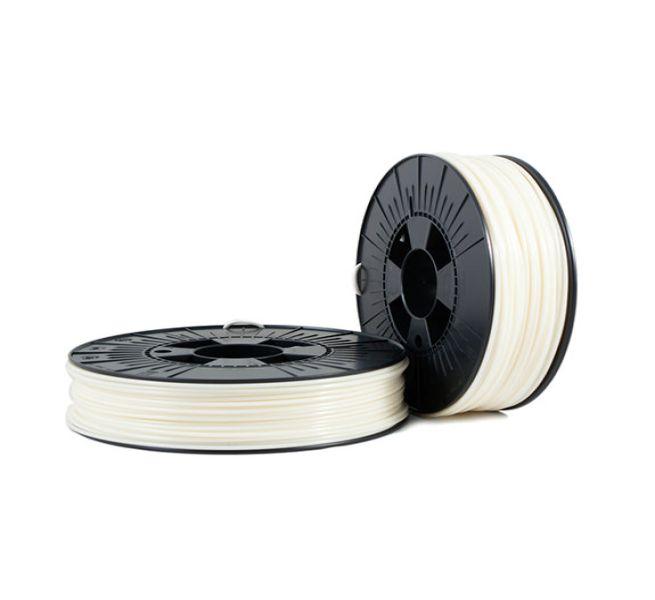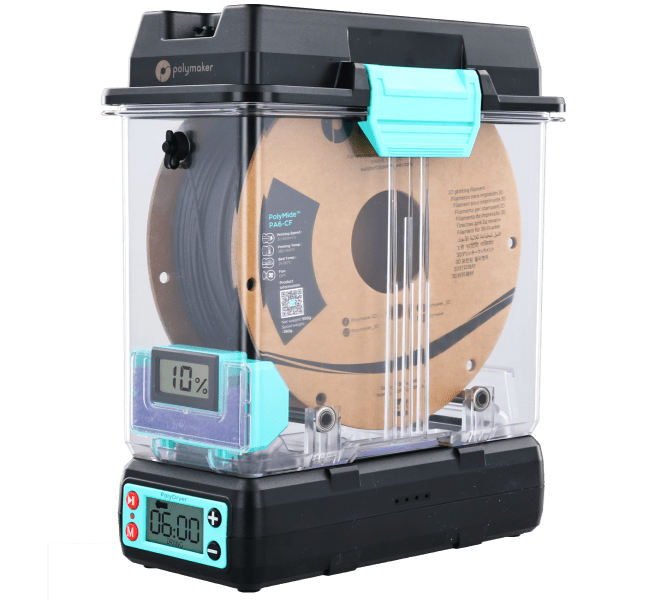PLA filament can break during storage or print, ruining your builds and significantly increasing production costs. You might notice sudden snaps midway through complex models or discover brittle spools that crumble when handled. Moisture, quality variations, mechanical stress and temperature fluctuations all contribute to filament failure.
The good news is you can reduce the chances of PLA filament breakage. Join us below for a crash course on solving the problem.
PLA Characteristics
- Printing temperatures of 205±10°C
- Minimal warping during cooling
- Biodegradable composition
- Tensile strength of approximately 66 MPa
Common Causes and Solutions for PLA Breakage
1. Poor Quality Filament
Manufacturing inconsistencies create weak points throughout filament length, leading to unexpected breaks during printing. Variations in diameter and poor material mixing during production compromise structural integrity regardless of printer settings.
Solutions
Selecting Reliable Brands
Purchasing from reputable sellers like Additive-X, who only stock filaments from manufacturers with strict quality control over production processes.
High-quality PLA filaments include:

Inspection Before Use
Examine filament for diameter consistency, discolouration, and defects before loading. Run filament between fingers to feel for thickness variations, which signal potential break or extruder jam points during printing operations.
2. Moisture Absorption
PLA absorbs moisture from the air, becoming brittle and prone to snapping when handled. Water molecules break down polymer chains, permanently weakening filament structure over time, particularly in humid environments.
Solutions
Proper Storage Techniques
To maintain dryness, store PLA in airtight containers with desiccant packets. Vacuum-sealed bags work particularly well for long-term storage, preventing moisture from reaching the filament, while vacuum pressure doesn’t damage the PLA structure.

Another option is the Polymaker PolyDryer, a dock and drying system for single filament spools. It supports PLA and most other filaments.
Related: Polymaker Filament and PolyDryer: Improving 3D Print Quality
Filament Drying Methods
Dry moist filament using purpose-built filament dryers or conventional ovens set below 45°C. Extended drying for 4-6 hours removes absorbed moisture, restoring flexibility and reducing breakage risk when loading filament through extruder paths.
3. Excessive Tension in the Extruder
Over-tightened extruder tensioning springs apply excessive pressure on the filament, creating deformations in soft PLA. Combine that with sharp feeding angles and these pressure points become breaking points during printing or retraction moves.
Solutions
Adjusting Tension Settings
Reduce extruder tension until filament feeds smoothly without slipping or gear biting. Start with minimal tension, then gradually increase until reliable extrusion begins, stopping before the filament shows visible deformation.
Modifying Filament Path
Create gentler filament paths without sharp bends between the spool and extruder. Use filament guides with wide curves rather than tight angles, which is particularly important for brittle PLA that cannot withstand acute bending stresses.
4. Age Degradation
PLA gradually deteriorates over time through reaction with oxygen and environmental factors, even when properly stored. Chemical bonds within polymer chains weaken, reducing flexibility and increasing brittleness throughout filament length.
Solutions
Rotation of Stock
Use older filament first rather than leaving spools unused for extended periods. Mark purchase dates on spools to track age, prioritising usage based on acquisition date rather than colour or project requirements.
Rejuvenation Techniques
Gently heat aged PLA below 40°C for 24 hours to encourage limited polymer relaxation. While this cannot fully restore degraded filament, mild heating improves flexibility by releasing internal stresses without approaching the glass transition temperature.
5. Incorrect Temperature Settings
Printing PLA at temperatures outside manufacturer recommendations affects polymer structure during extrusion. Too-cold settings create partial melting and weak layer adhesion, while excessive heat degrades material strength through polymer chain breakdown.
Solutions
Finding Optimal Temperature Range
Run temperature towers to identify the ideal temperature within the manufacturer recommended extrusion range. Different colours may require slight adjustments, with darker pigments often printing optimally at lower temperatures within the specified range.
Adjusting for Ambient Conditions
Modify the printing temperature based on the workshop environment. Cold workshops require temperatures toward the upper end of the range, while warm rooms allow printing toward the lower end of manufacturer specifications.
6. Clogged Nozzle Problems
Partial nozzle blockages create back pressure in the hotend assembly, forcing the extruder to push the filament harder. Increased pressure combines with heat softening to deform the filament above the hotend, creating weak spots vulnerable to breaking.
Solutions
Regular Maintenance Schedule
Clean the nozzle regularly using hot & cold pulls with a dedicated cleaning filament or mechanical cleaning needles. Remove and inspect hotend components monthly, ensuring heat breaks remain clean, PTFE liners show no signs of deformation or carbonisation and that hotend cooling fans are free from debris and obstruction affecting performance.
Nozzle Replacement
Replace worn nozzles when extrusion becomes inconsistent despite cleaning attempts. Brass nozzles lose precision after printing approximately 3-5kg of PLA, and worn openings cause inconsistent extrusion patterns and an increased likelihood of clogs.
Preventing Future Breakage
Take control of preventative maintenance schedules for printer components that contact filament. Regularly inspect extruder gears, PTFE tubing and hotend assemblies for wear which increases breakage risk through uneven filament movement or excessive friction.
Monitor room humidity levels, keeping printing environments below 40% relative humidity when possible. Consider installing hygrometers near printer stations to track environmental conditions affecting filament performance between prints.
Review printing speeds and acceleration settings which affect filament stress during direction changes. Slower print speeds reduce mechanical strain on the filament path while maintaining print quality without risking breaks during complex printing movements.




